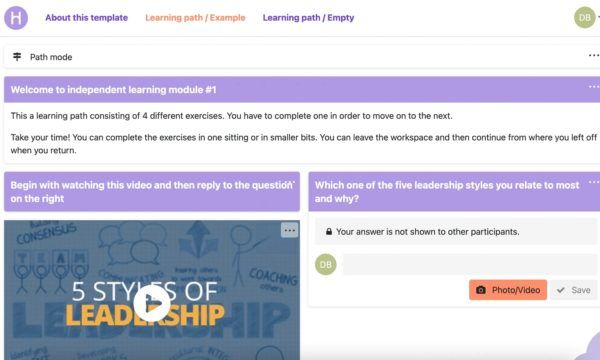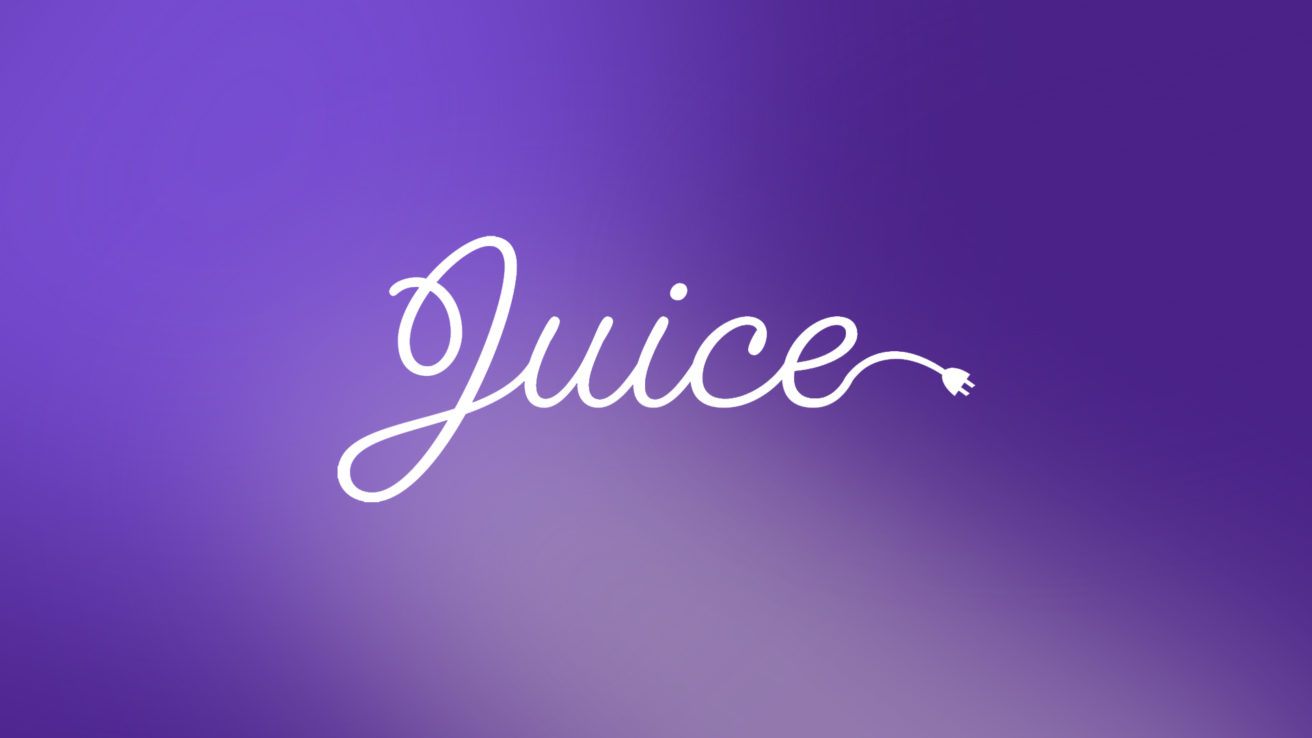
Juice Inc.
How Juice Inc. structures the learning experience to boost team energy and strengthen engagement
Challenge
Juice is a consultancy based in Guelph, Ontario, that runs transformative training programs. They help companies all around the world to energize their teams by growing leadership capabilities, sustaining employee engagement, and enabling innovation. Until COVID-19, Juice ran its training programs exclusively in person. They needed an effective solution to allow them to digitize their training programs effectively.
Solution
“At the beginning of the pandemic, when we were looking into how to virtualize training properly, my first thought was “We need to get Howspace”, ” says David Donaldson, Director of Client Solutions at Juice. As a company that formerly offered only in-person training, Juice has not only converted its in-person training into a virtual environment but has introduced a new learning model and identified new business opportunities.
Results
In the learning and development (L&D) industry, there’s a lot of training that happens just for the sake of it rather than to make a difference. Like when an organization has to spend their L&D budget but hasn’t considered what knowledge or skills gap needs to be closed. Or there’s no agreed-upon yardstick for success.
So what does a purposeful and evidence-based training program look like?
Juice is a consultancy based in Guelph, Ontario, that runs transformative training programs. They help companies all around the world energize their essential people and teams in three key ways: 1) growing leadership capabilities, 2) sustaining employee engagement, and 3) enabling innovation.
Having exclusively run in-person training programs before COVID-19, Juice not only moved those programs to the virtual space with Howspace but also shifted to a new learning model and identified new business opportunities.
Moving away from one-day training events
David Donaldson, Director of Client Solutions at Juice, had first discovered Howspace as a participant at the Toronto Change Days—a three-day immersive festival of change. For two years after that inaugural event, he was an active and important member of a community brought together via the Howspace platform.
“At the beginning of the pandemic, when we were looking into how to virtualize training properly, my first thought was “We need to get Howspace,” says David.
After one of Juice’s clients had to reschedule their live training program twice because of COVID-19, Juice helped them run the program virtually with Howspace. This first Howspace-supported program was a success, and Juice then duplicated that program for other cohorts, running it almost unedited.
“In L&D, we’ve been fighting against this classic model of one-day events where people join a program without having done any sort of pre-work. When we were forced to go virtual, people realized that it could actually be very effective when done correctly. And now the acceptance for multiple shorter events exists,” says Jean-François Hivon, General Manager and VP of Sales at Juice.
Reimagining learning and shifting accountability
Letting go of old learning models isn’t easy—some people are still applying unconscious constraints of the physical world to the virtual world. “In order to excel in the virtual world, we have to let go of some constraints and reimagine what learning could look like,” says Jean-Francois.
“In order to excel in the virtual world, we have to let go of some constraints and reimagine what learning could look like.”
Howspace has enabled Juice to let go of those constraints and shift the learning experience. Jean-François explains: “One of the things that have to shift within L&D is not only how we deliver learning, but how learners participate in learning. The old model is, in a sense, the learner as a consumer. A learner goes to your classroom, and you give them new knowledge, and they consume that and maybe share some insights. COVID has started to rebalance things so that it’s more of a partnership, where the learner is an active contributor and independent person who has to take ownership over their learning experience.”

Jean-François continues: “I think it’ll take time for learners to adapt and see the pre-work as part of the learning—not as a side job. As designers, it’s on us to show learners that it’s actually part of the learning experience.”
Howspace also allows for a shift in accountability when it comes to learning. L&D providers generally lose track of what participants do after training programs, and to some degree, we wipe their hands off the accountability for impact because they have no control. But when you can provide a structure that captures learners’ insights and when those insights are visible and shareable, then you understand what participants are getting out of the training.
“With Howspace, accountability is built right into the learning design. By enhancing accountability, we also enhance the learning because people are forced to translate what they consume into insights,” says Jean-François.
He continues: “Howspace opened up new business opportunities for us—we’re now working more with larger virtual engagements. People see the value of reimagining their events and bringing people together in a virtual space. We have to think about it differently and build it differently, but Howspace is enabling us to show people what it could look like literally.”
A sense of community grows organically within Howspace
Let’s take a closer look at how Juice designs a learning journey where participants naturally interact with one another. For one of their clients, Juice created the map below to show participants what the learning journey for their Beyond Engagement Training looks like.
After the kick-off, participants are asked to do some reading and reflect on some questions, which they answer in Howspace. Steps one to three are synchronous events, and the cohort gets together for a celebration after the participants have had the chance to apply the concepts they learned.
At the beginning of the program, when participants were asked to introduce themselves, they embraced the technology and interacted with each other.

“Howspace enables us to create a community of practitioners that are all supporting each other and helping each other on their learning journeys. You get a bunch of people who come into Howspace, and then they just start sharing—it just grows organically,” says David.
Juice also shares all its resources in the Howspace workspace to support participants on their journey.
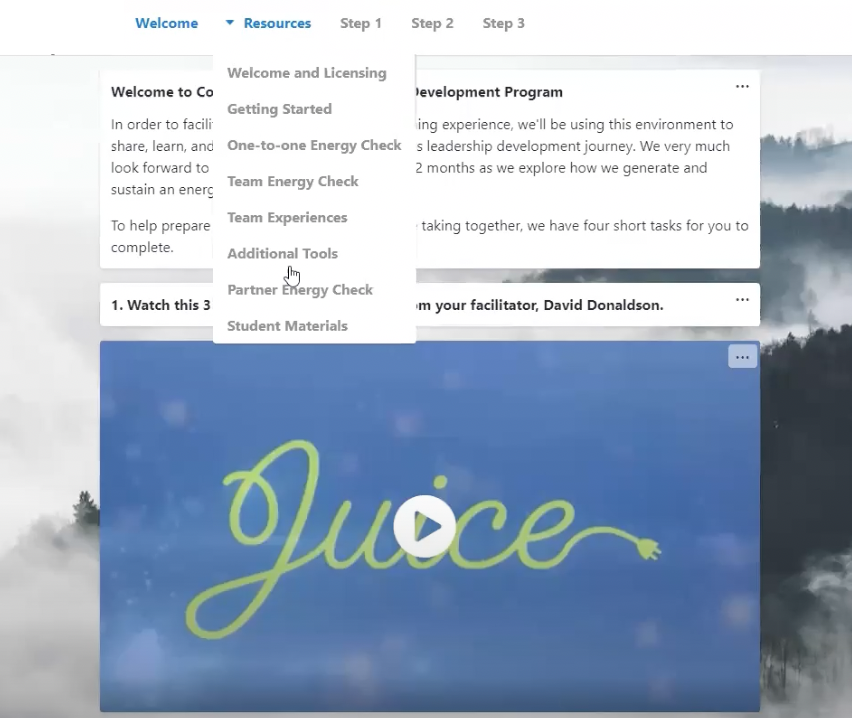
To make it simple and easy for people to engage with one another, Juice asks probing questions at different points throughout its training program, as seen below.
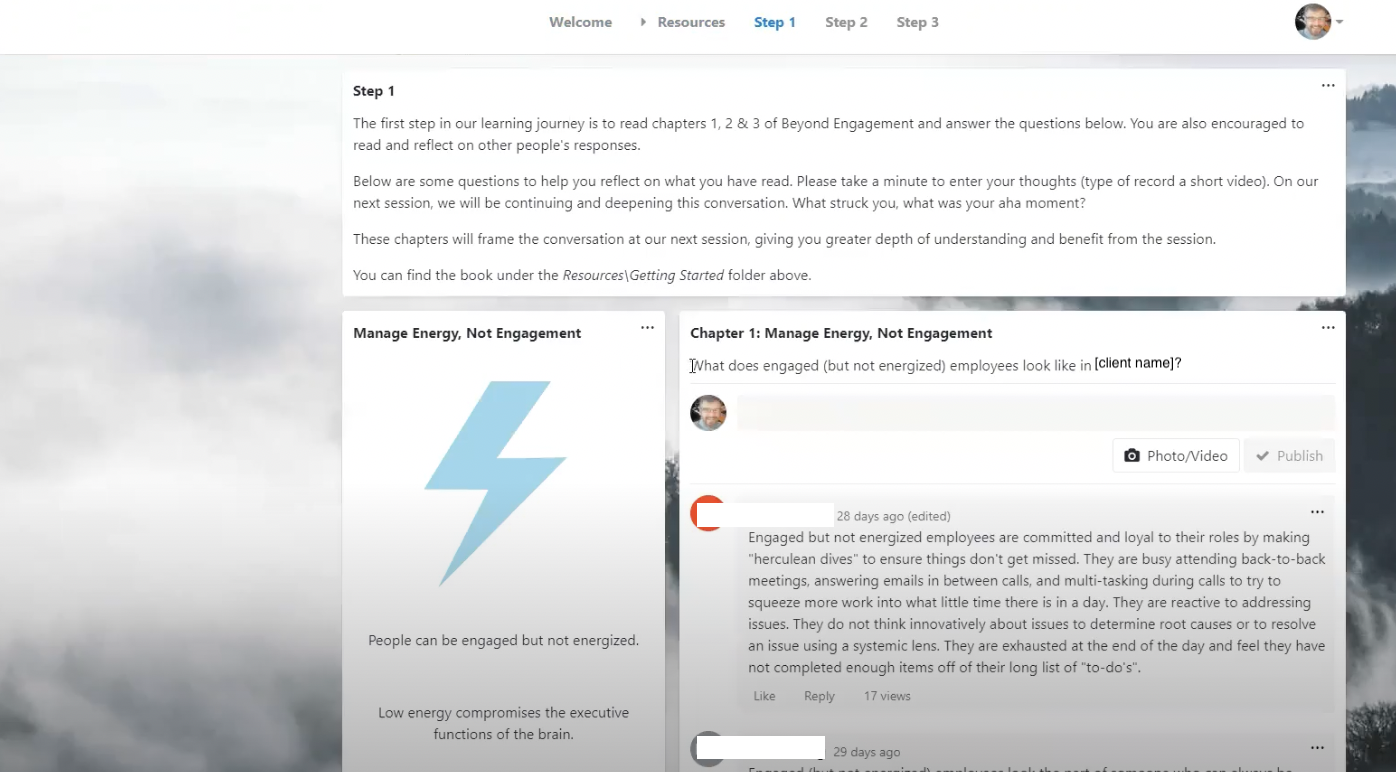

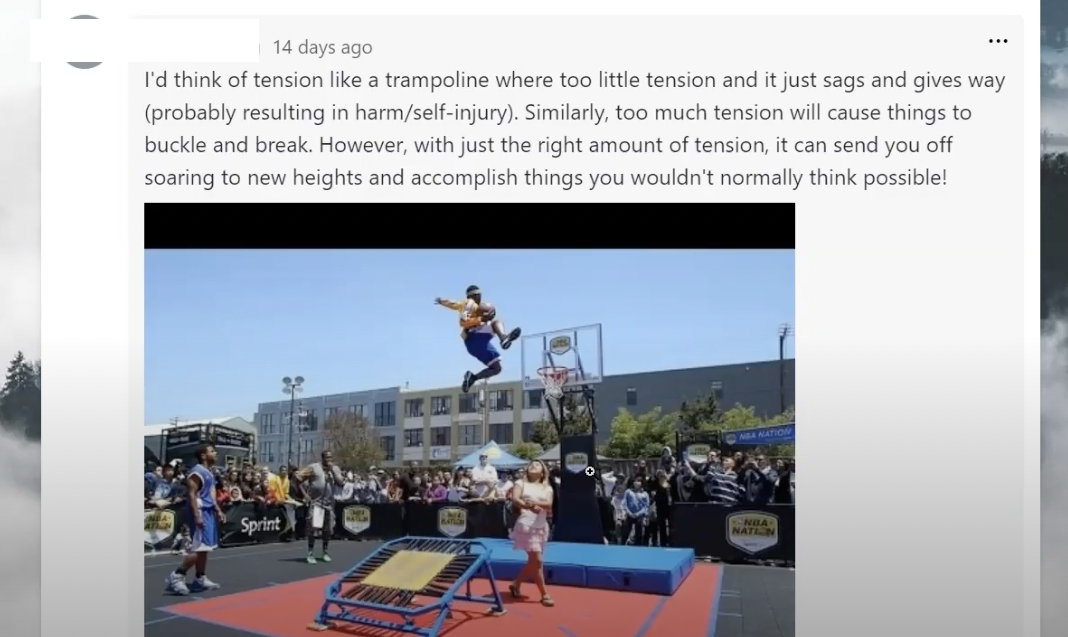
Participants can also book a coaching call with David directly through Howspace. “Previously, we had a long spreadsheet of 20 people, and we were sending multiple emails and following up. Now I can send a quick email from within Howspace to remind participants to book a call. It’s been a really effective way of getting people engaged,” says David.

“Because of Howspace and how it works, we’re able to have a conversation that actually spans three months, not three hours. We’re getting a deeper insight into how people engage with our materials, which enables us to tweak not only the materials themselves but the delivery. It’s enabling us to reach these larger wider audiences, but also create that larger sense of community.”
“Because of Howspace and how it works, we’re able to have a conversation that actually spans three months, not three hours.”
For example, Juice can connect people from their different client companies who went through the same training program so they can share learnings and discuss with each other.
What’s the next phase of learning & development?
With the rise of hybrid learning, we’re going through the next transition for learning and development. “Our first transition was from classrooms to all virtual, and the next transition in this learning space is bringing the needle back to asking, “What should be in-person, and how do we blend that with what we’ve learned from a virtual learning environment?” says Jean-François
Juice sees the potential for taking the self-directed learning journey model a step further. Whereas now, for a three-month learning journey with a cohort of 20 people, Juice defines the stops along the way where they gather for synchronous events, there’s room for change.
“We could go even more into a self-directed model where the teams can get together on their own schedules instead of waiting for the facilitator to set those dates. I’m interested in exploring the potential of ditching Zoom and having Howspace become their environment for seamless synchronous and asynchronous learning,” explains Jean-François.
“The level of partnership that Howspace is committing to is amazing”
Juice is among the 160+ passionate partners we work with at Howspace, with the shared goal of engaging people better.
“Howspace is our only provider from a pure technology perspective that has invested that much time helping us leverage the platform and helping us learn new ways of working. It’s just been phenomenal—the level of partnership that Howspace is committing to is amazing,” says Jean-Francois.
Note: David Donaldson made the transition from working at Juice Inc. to Howspace after this case study was written.
Similar customer stories
View all
Stronger culture and better business results with Howspace
Discover how HomeMaid transformed its culture and business results with Howspace, boosting employee engagement and reducing turnover significantly.

Leading trade union innovation and learning: How Unions 21 enables unions to claim their agency
Discover how Unions 21 empowers trade unions through inclusive, engaging online learning with Howspace—helping them stay connected, adapt to change, and lead renewal across the movement.
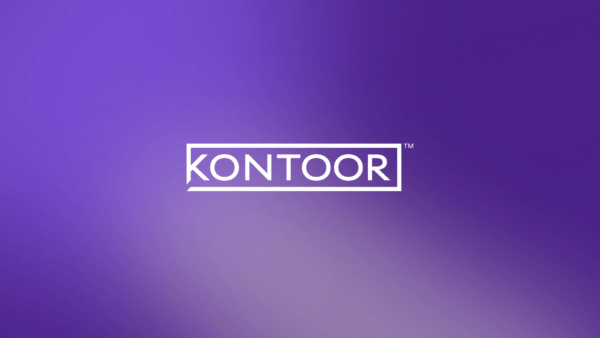
Scaling leadership development across continents—without compromising engagement
Discover how Kontoor Brands transformed leadership development across continents with Howspace, improving engagement and creating a stronger global community.
Templates used in similar cases
View all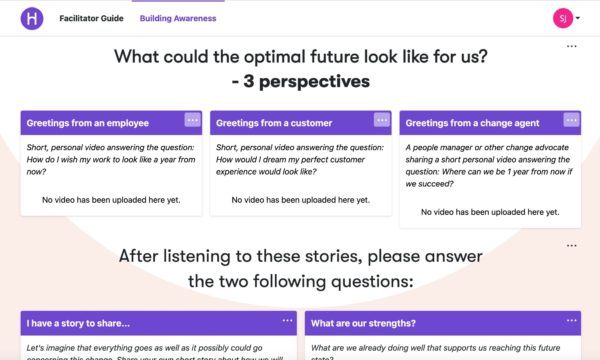
ADKAR: Awareness Stage
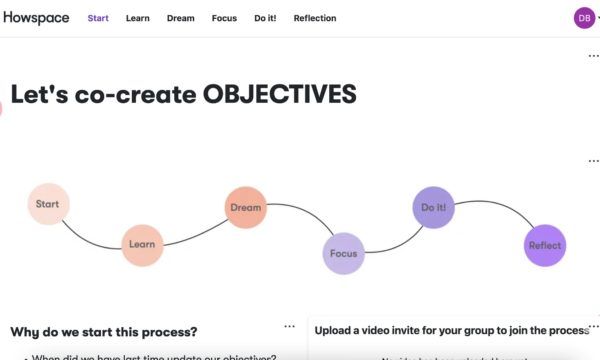
Co-creating 4D Objectives
